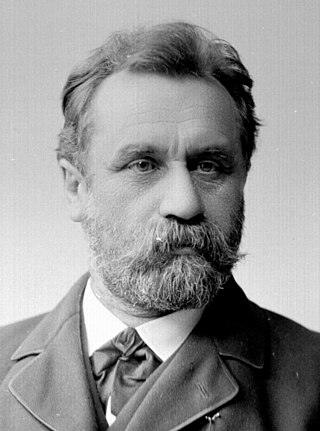
The Galtung family was a Norwegian noble family dating from the ennoblement of Lauritz Galtung in 1648. However, when he was ennobled, documents indicated the family descended from an older noble family, the Galte family. This led to both Hardanger families being referenced as Galtungs in history books.

Niels Juel was a Danish admiral and naval hero. He served as supreme command of the Dano-Norwegian Navy during the late 17th century and oversaw development of the Danish-Norwegian Navy.

Ulrik Frederik Gyldenløve, Landgrave of Laurvig was Governor-general of Norway from 1664–1699. He was the leading general in Norway during the Scanian War, whose Norwegian leg is conventionally named the Gyldenløve War after him. In Norway he was also the Landgrave of Laurvig.
The aristocracy of Norway is the modern and medieval aristocracy in Norway. Additionally, there have been economical, political, and military elites that—relating to the main lines of Norway's history—are generally accepted as nominal predecessors of the aforementioned. Since the 16th century, modern aristocracy is known as nobility.

The House of Danneskiold-Samsøe is a Danish family of high nobility associated with the Danish Royal Family, and who formerly held the island of Samsø as a fief.

The Count of Wedel-Jarlsberg is a title of the Norwegian nobility and of the Danish nobility. The family of Wedel-Jarlsberg is a branch of the larger family von Wedel, which comes from Pomerania, Germany. Family members have had a significant position in the 18th and 19th centuries' Norwegian history.

Bredo Henrik von Munthe af Morgenstierne was a Danish-Norwegian jurist who served as the first Attorney General of Norway from 1816 to 1820. He belonged to a Danish and Norwegian noble family.

Jens Tillufssøn Bjelke was a Danish-Norwegian nobleman and a feudal lord of Jemtland, Norway, was originally from Danish Skåne. Jens Tillufssøn Bjelke was one of several notable Danes who acquired land, resided permanently in Norway, became thoroughly Norwegian and founded new Norwegian noble families, which replaced the old nobility of the first rank. He was the grandfather of Chancellor Jens Ågessøn Bjelke and great-grandfather of Governor Jorgen Bjelke.

Henrich Krummedige, was born circa 1464 in Norway and died in 1530. He was a Danish-Norwegian nobleman and a member of both the Norwegian and Danish National Councils (Rigsråd) and played an extensive role in the politics of the era. He served as commanding officer of the Bohus Fortress in Norway from 1489 to 1503.

Foreign nobility in Norway refers to foreign persons and families of nobility who in past and present have lived in Norway as well as to non-noble Norwegians who have enjoyed foreign noble status. Although being noble in their native countries, their foreign noble status did not automatically lead to naturalisation when entering the Kingdom. While some immigrant families were naturalised and became a part of the Norwegian nobility and later the Dano-Norwegian nobility, like Wedel-Jarlsberg, others did not apply for or receive a particular recognition, like de Créqui dit la Roche.
The Norwegian patriciate was a social class in Norway from the 17th century until the modern age; it is typically considered to have ended sometime during the 19th or early 20th century as a distinct class. Jørgen Haave defines the Norwegian patriciate as a broad collective term for the civil servants (embetsmenn) and the burghers in the cities who were often merchants or ship's captains, i.e. the non-noble upper class. Thus it corresponds to term patriciate in its modern, broad generic sense in English. The patricians did not constitute a legally defined class as such, although its constituent groups, the civil servants and the burghers held various legal privileges, with the clergy de jure forming one of the two privileged estates of the realm until 1814.
Events from the 1590s in Denmark.

The Hartvig Nissen School, informally referred to as Nissen, is a gymnasium in Oslo, Norway. It is located in the neighborhood Uranienborg in the affluent West End borough of Frogner. It is Norway's oldest high school for girls and is widely considered one of the country's two most prestigious high schools alongside the traditionally male-only Oslo Cathedral School; its alumni include many famous individuals and two members of the Norwegian royal family.

Jørgen Kaas was a Danish colonel, lord of the fiefdom Lister in Norway, and owner of the Hastrup and Østergaard estates in Denmark. A member of the younger Kaas family, one of Denmark's preeminent families of ancient high nobility, he is notable as a war hero during the March across the Belts when he led the defense of Fyn against the Swedes and fell in battle. King Charles X Gustav of Sweden accompanied his body on foot in honour of his bravery. He was given the fief of Lister by King Christian IV on 30 December 1648, after he had sold his estate Østergaard to the King's son Ulrik Christian Gyldenløve. He never resided in Norway, and the fief was administered by the fiefholder of Nedenes.

Henrik Jørgen Huitfeldt-Kaas was a Norwegian historian and Director-General of the National Archives of Norway (riksarkivar).

Birgitte Christine Kaas, married Huitfeldt was a Norwegian poet and translator of hymns.

Bernhard Cathrinus Pauss was a Norwegian theologian, educator, author and humanitarian and missionary leader, who was a major figure in girls' education in Norway in his lifetime.
Munthe is a surname, mainly used in Scandinavia. Notable people with the surname include:

Ulrich Jørgensen Kaas was a member of the old noble family of Mur Kaas, and an officer in the Dano-Norwegian navy. He rose to the rank of rear admiral in the Great Northern War and later to full admiral in 1732. Following a power struggle within the Danish admiralty, he left the naval service for a senior post in Bergen.


















